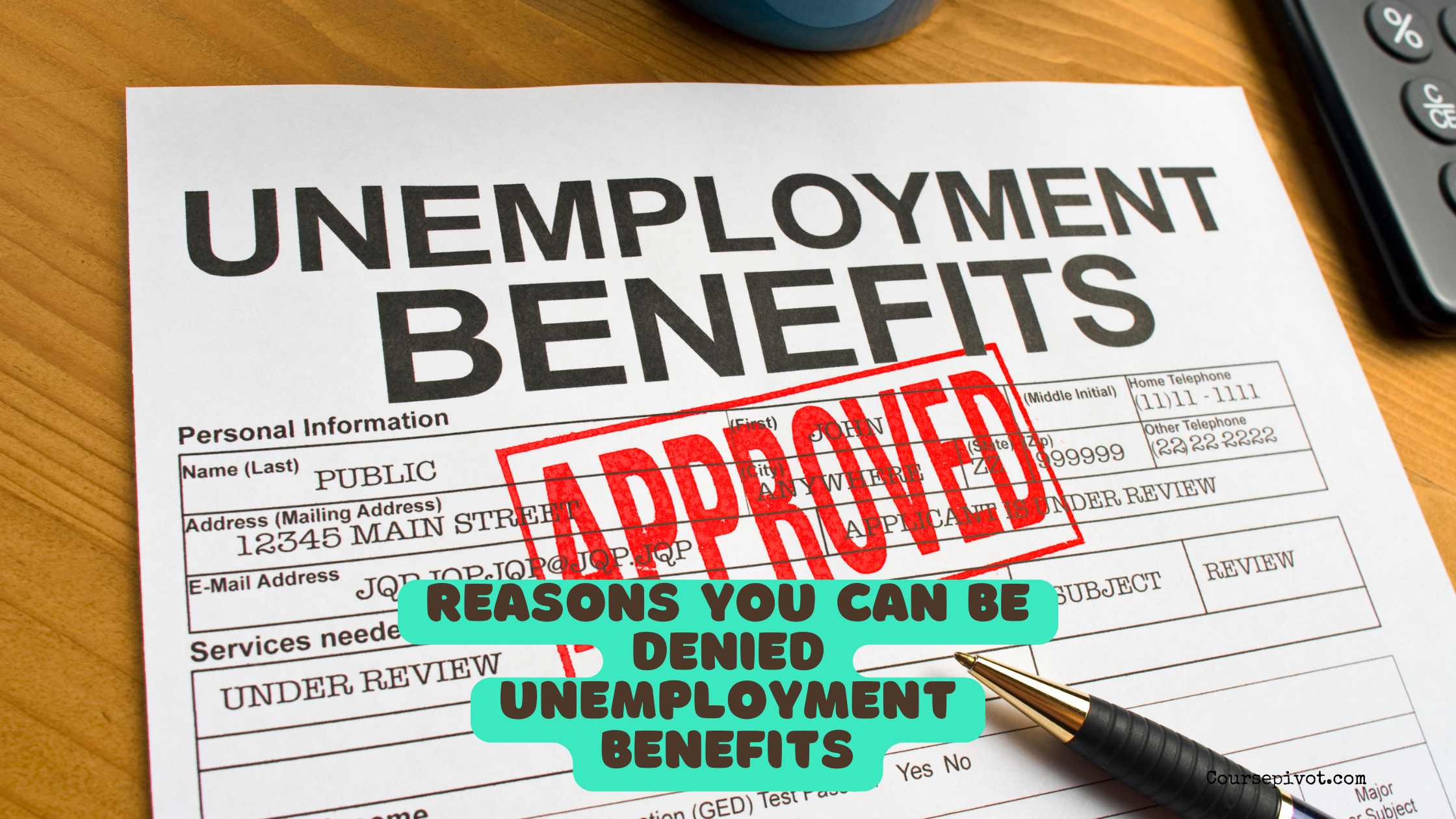
Reasons You Can Be Denied Unemployment Benefits
Unemployment insurance (UI) provides temporary financial support to workers who lose their jobs through no fault of their own, but denials are common—up to 30% of claims in some states like Ohio. Administered by states under federal guidelines, UI eligibility hinges on factors like earnings, job separation reasons, and ongoing requirements.
This guide outlines the most common legal reasons for denial or disqualification, drawing from U.S. Department of Labor standards and state-specific rules. While federal law sets broad parameters (e.g., via the Social Security Act), states define details—leading to variations.
Table of Contents
Denials aren’t final: every state offers an appeals process, with success rates often exceeding 50% (e.g., 80% in California during peak pandemic claims). If denied, you’ll receive a notice explaining the reason and appeal instructions. Always appeal within the deadline (typically 10–30 days) and gather evidence like pay stubs, emails, or witness statements. For personalized advice, consult your state’s UI agency or a legal aid organization.
Common Reasons for Denial Across the U.S.
These apply nationwide but may vary in severity or definition by state. The U.S. Department of Labor lists key disqualifiers, emphasizing “no fault of your own.”
- Insufficient Earnings or Work History
You must meet “monetary eligibility” during the base period (usually the first four of the last five completed quarters). This often requires working in at least two quarters and earning 1–1.5 times your highest quarter’s wages. Denials occur if wages fall short—e.g., gig workers or recent hires.
Federal Note: States set thresholds; appeals succeed with corrected employer wage reports. - Voluntary Quit Without Good Cause
Quitting for personal reasons (e.g., dissatisfaction, relocation without job ties) disqualifies you. “Good cause” means a compelling work-related issue, like unsafe conditions or harassment, where you exhausted alternatives (e.g., complaints). Personal reasons like family care rarely qualify federally, though some states (e.g., CA) allow exceptions for domestic violence. - Discharge for Misconduct
Fired for willful violation of rules, policy breaches (e.g., theft, insubordination, drug use), or poor performance despite warnings. Simple incompetence or inability (e.g., unmet standards without intent) often doesn’t qualify as misconduct. Appeals hinge on proving the act wasn’t deliberate. - Refusal of Suitable Work
Turning down a reasonable job offer (similar pay, location, hours) without good cause. “Suitable” considers your skills, prior wage (up to 75–100% threshold after initial weeks), and health. Federal law requires active job search (2–5 contacts/week). - Not Able/Available for Work
Incarceration, full-time school, disability without part-time capacity, or caregiving duties that prevent full availability. You must be ready to start work immediately. - Failing Ongoing Requirements
Not registering with job services, insufficient job searches, or unreported earnings (e.g., part-time work exceeding benefit reductions). Fraud (false statements) leads to permanent bans and repayment. - Receiving Other Payments
Severance, vacation pay, or pensions may delay or reduce benefits. Workers’ comp or disability often disqualifies if it implies inability to work. - Fraud or Misrepresentation
Knowingly lying on applications (e.g., hiding income) triggers denial, overpayment recovery, and penalties like fines or jail. Federal audits flag inconsistencies. - Seasonal or Contractual Employment Issues
School employees between terms or athletes off-season may be denied if “reasonably assured” of recall. - Other Disqualifiers
Trade disputes (strikes), incarceration, or self-employment without covered wages.
State-by-State Variations
States interpret federal rules differently—e.g., “good cause” for quitting is narrower in GA than CA. Below is a table summarizing key variations for major states (top 10 by population). Always verify with official sites.
| State | Key Denial Reasons (Beyond Common Ones) | Appeal Deadline | Official Resource for More Info |
|---|---|---|---|
| California | Late filing; failure to complete training; moving out-of-state without notice. Strict on misconduct (e.g., absenteeism as defense). | 30 days | EDD.ca.gov – Appeals section with forms and hearing prep. |
| Texas | Poor performance if capable (e.g., neglect); quitting for non-work reasons; additional payments like severance delay benefits. High bar for “good cause” quits. | 14 days | TWc.texas.gov – UI Appeals Process page. |
| Florida | Still working/earning >$275/week; not registering on Employ Florida; malicious misconduct (e.g., intentional harm). No personal quit reasons. | 20 days | FloridaJobs.org – Reemployment Assistance Appeals. |
| New York | < $2,400 in one base quarter; quitting for marriage/personal; misconduct like policy violations. Performance firings often qualify if not willful. | 30 days (or show good cause for late) | DOL.ny.gov – UI Hearing Process FAQs. |
| Illinois | Not verifying identity; quitting without compelling reason (e.g., unsafe conditions); SSDI overlap if unable to work. Tardiness as misconduct if willful. | 30 days | IDES.illinois.gov – Appeals and Hearings. |
| Pennsylvania | Refusal of recall/suitable work; willful misconduct (e.g., violation without good cause); not seeking work. Narrow good cause for quits. | 21 days | UC.pa.gov – Appeal a UC Service Center Determination. |
| Ohio | Voluntary quit prior to qualifying job; unsatisfactory performance without just cause; not meeting 20 weeks/$269/week. Drug tests as misconduct. | 21 days | JFS.ohio.gov – Unemployment Compensation Review Commission. |
| Georgia | Quit without “good work-connected” reason (no personal); discharge for insubordination or unknown rules. Employer misclassification common denial trigger. | 15 days | DOL.georgia.gov – File an Appeal page. |
| North Carolina | Health/family quits (post-2013 tightening); refusal after 10 weeks; school breaks for educators. Tardiness if not excused. | 20 days (initial); 15 days (further) | DES.nc.gov – Appeals and Adjudication FAQs. |
| Michigan (Bonus for Midwest) | Misconduct including minor policy breaches; insufficient searches (5/week); severance offsets. | 30 days | Michigan.gov/LEO – UI Appeals. |
Table based on state statutes and DOL data; thresholds/definitions subject to change—verify via links.
Appealing a Denial: National Steps
- Review Your Notice: It cites the exact reason (e.g., UI Code section) and deadline.
- File Promptly: Online, mail, or fax—include evidence summaries.
- Prepare for Hearing: Phone/in-person with a referee; present facts calmly. Bring docs (e.g., emails proving “good cause”).
- Seek Help: Free legal aid via Legal Services Corporation or state bar referrals. Success tips: 70% win with representation in CA/IL.
- Further Appeals: If lost, go to state board/court (e.g., NC Board of Review).
Federal Resources for All States
- U.S. DOL UI Finder: oui.doleta.gov – State contacts and denial info.
- CareerOneStop: careeronestop.org – Tool for state-specific eligibility quizzes.
- USA.gov Unemployment: usa.gov/unemployment – Pandemic extensions and fraud reporting.
What is the best reason to put for unemployment?
1. Employer-Initiated Separation (No Fault of the Employee)
This category is the most reliable for establishing unemployment eligibility, as it directly proves the separation was due to the employer’s operational decisions.
- Layoff or Reduction in Force (RIF): This occurs when a company eliminates a position or reduces staff due to economic factors, restructuring, or lack of work, not the employee’s performance.
- Legal Basis: Nearly all state unemployment statutes incorporate the “no fault” standard derived from the original intent of the Federal Unemployment Tax Act (FUTA), contained within the Internal Revenue Code, Title 26 U.S.C. § 3301 et seq. This standard mandates that states provide compensation for “involuntary unemployment.”
- Lack of Work or Business Closure: The facility or business where the claimant worked has permanently or temporarily ceased operations.
- Legal Basis: This is considered the textbook example of involuntary unemployment, typically ensuring immediate eligibility, provided the claimant meets the state’s minimum “base period” (wage and work history) requirements, which are governed by each state’s labor code (e.g., California Unemployment Insurance Code or New York Labor Law Art. 18).
2. Voluntary Quit for “Good Cause” Attributable to the Employer
Quitting a job generally results in a disqualification. However, all states have exceptions, allowing benefits if the employee quit for “good cause” that is “compelling and necessitous” and, crucially, “directly attributable to the employment or the employer’s actions.” The employee must also typically show a “good faith effort” to resolve the issue with the employer before quitting.
A. Significant Deterioration of Working Conditions
This involves a substantial, detrimental change in the job compared to the time of hire.
- Substantial Reduction in Wages or Benefits: A significant, non-temporary decrease in pay rate, hours, or benefits.
- Legal Basis: This often constitutes “good cause.” For example, the Pennsylvania Supreme Court ruled that a pay cut can be “necessitous” reason to quit (Taylor v. UCBR, 378 A. 2d 829 (1977)).
- Unsafe Working Environment: The employer fails to correct hazardous or illegal working conditions after being notified.
- Legal Basis: Quitting due to conditions that violate health and safety laws is generally considered good cause, as the worker’s safety takes precedence (e.g., failure to fix known, documented safety risks).
- Documented Harassment, Discrimination, or Employer Law Violation: Leaving due to a hostile work environment, or the employer violating anti-discrimination, wage, hour, or collective bargaining laws.
- Legal Basis: Many state unemployment statutes or case law recognize that an employer’s breach of a legal duty (such as providing a workplace free of harassment) constitutes good cause for a voluntary separation.
B. Medical Necessity
Quitting due to a physical or mental condition affecting the ability to perform the job.
- Personal Medical Condition: The employee’s health condition (verified by a medical professional) prevents them from performing their job, and the employer cannot or will not offer a reasonable accommodation or leave of absence.
- Legal Basis: Nearly all states permit “good cause” quits for personal medical reasons, provided the claimant made an effort to preserve their employment (e.g., requested a leave) before resigning.
3. Voluntary Quit for “Compelling Family Reason”
A growing number of states have statutes specifically carving out exceptions for compelling family or domestic reasons. This is not universally recognized, but where applicable, it establishes eligibility.
- Domestic Violence, Sexual Assault, or Stalking: Leaving employment to protect oneself or an immediate family member.
- Legal Basis: Many states, like New York, have amended their Labor Law (New York Labor Law § 593(1)(b)) to include explicit provisions that separation due to domestic violence is a “compelling family reason” that does not result in disqualification.
- Military Spouse Relocation: Quitting to accompany a spouse whose active military duty requires a change of station to a location too far to commute.
- Legal Basis: The U.S. Department of Labor issued guidance encouraging states to adopt this good cause provision, and most have done so through statute or regulation.
Government Resources and Legal Framework
The core framework for Unemployment Insurance is federal, but enforcement and specific definitions are state-level.
| Legal/Statutory Authority | Description and Key Principles |
| Federal Unemployment Tax Act (FUTA) (26 U.S.C. § 3301 et seq.) | Establishes the federal framework and payroll tax structure for the UI system, mandating that states offer compensation to eligible workers. |
| Social Security Act of 1935 (Title III & IX) | Created the Federal-State system of unemployment compensation and provided for grants to states for administration. |
| State Unemployment Compensation Statutes | Each state’s specific labor code (e.g., Texas Labor Code Title 4 or Florida Unemployment Compensation Statutes) defines the “base period,” benefit amounts, and the precise legal definitions of “misconduct” (which disqualifies) and “good cause” (which preserves eligibility). |
| U.S. Department of Labor (DOL) | Provides guidance and oversight. The DOL website offers state-by-state information on eligibility: https://www.dol.gov/general/topic/unemployment-insurance |
| Cornell Law School Legal Information Institute (LII) | Provides a useful index of links to State Unemployment Laws for research: https://www.law.cornell.edu/wex/table_unemployment |
The most common and definitive reason for receiving unemployment benefits is “Layoff” or “Lack of Work,” as this represents an involuntary separation from employment that is through “no fault of the employee.”
Most Common Qualifying Reason: Layoff / Lack of Work
The core mission of the Unemployment Insurance program is to provide temporary wage replacement for individuals who lose their jobs due to economic factors.
- Layoff: This includes company downsizing, reduction in force (RIF), position elimination, or business closure. This category aligns directly with the “no fault” requirement, making it the least likely to result in a disqualification hearing.
- Legal Principle: The UI system is designed specifically to address unemployment arising from cyclical and structural unemployment—factors outside the worker’s control.
Supporting Statistics & Data Trends
Statistics are often presented in terms of issues that lead to overpayments (i.e., claims that were initially approved but later found to be ineligible) or denials, which indirectly highlights the most common reasons for scrutiny.
| Statistic (Based on US Department of Labor Audit) | Value | Context/Explanation |
| Separation Issues as a Cause of UI Overpayment | 23.74% (in 2023) | This is the second-highest cause of UI overpayments after “Benefit Year Earnings.” This means that in nearly a quarter of all overpaid cases, the employee was initially approved but later found to be ineligible due to the true reason for separation (e.g., they claimed “layoff” but were later found to have quit or been fired for misconduct). This demonstrates how frequently job separation reasons are contested or misrepresented in claims. |
| Eligibility Issues Cited by Non-Applicants | 55.1% (of unemployed people who did not apply in 2022) | The BLS found that the main reason unemployed people who had worked in the past year did not apply for benefits was that they believed they were ineligible. Eligibility issues often stem from: they quit, they were terminated for misconduct, or their past work was insufficient. This shows that voluntary separation (quits) and termination for cause are common reasons for unemployment but typically lead to claim denial. |
Conclusion from the Data
The most common reasons for being unemployed (quitting, firing for misconduct) are the most common reasons for being disqualified from receiving benefits. Conversely, being laid off is the most common reason for being approved for benefits, as it faces the least legal challenge under the “no fault” principle.
Common Reasons for Disqualification
Reasons that lead to disqualification also represent a large volume of claims, though they are usually denied:
- Voluntary Quit Without Good Cause: An individual simply deciding to leave their job.
- Fired for Misconduct: Termination due to willful disregard of an employer’s interests or rules (e.g., gross insubordination, repeated unexcused absences, theft).
The focus of the State Unemployment Agency’s adjudication process is generally to verify that the claim does not fall into one of these two disqualifying categories. Therefore, a claim based on Layoff/Lack of Work is the most effective and common path to approval.
Key Takeaways
Denials often stem from job separation fault (quit/misconduct: 60% of cases nationwide) or paperwork errors—appeal aggressively with proof. States like CA/IL offer broader “good cause” protections, while TX/FL are stricter on quits. You’re eligible if laid off or fired without fault—don’t let a denial stop you. Check your state’s site immediately; benefits average $300–$500/week, lasting 12–26 weeks. For hardship, explore SNAP or local aid. This guide empowers you—file smart, fight fair.
Cite this article
You can copy and paste your preferred citation format below.
Martin, L. & Arquette, E.. (2025, November 12). Reasons You Can Be Denied Unemployment Benefits. Coursepivot.com. https://coursepivot.com/blog/reasons-you-can-be-denied-unemployment-benefits/



